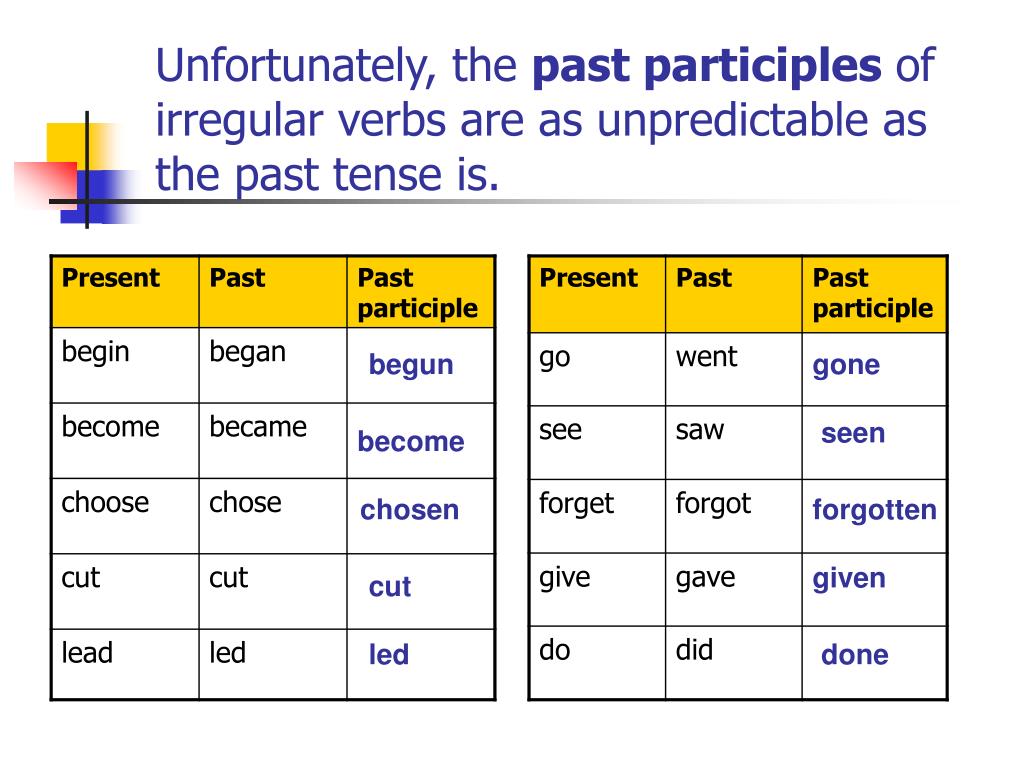
In standard English, using seen with I requires a form of the helping verb have, as in I have seen (present perfect) or I had seen (past perfect).Īlthough it is considered nonstandard, the phrase I seen is sometimes used as a past tense form in a variety of English dialects, as in I seen her yesterday. The word saw can be used with either a singular or plural subject, as in I saw, she saw, you saw, we saw, they saw, etc. Since saw is the past tense form of see, I saw is considered the standard form when describing past events. Choose the synonym for jealous conscious envious confident WORDS RELATED TO. form it ( by combining the auxiliary verb have with the past participle of the. Another word for CAUSE > Synonyms & Antonyms Cause Past Tense The past tense. Some verbs are even more irregular than see, such as the verb be, whose forms include is and are, was and were, and been and being. Grammar is often defined as the rule system of a language, but it is also. A bear was seen at the campsite yesterday.The form of be that you use is determined by the subject and/or a modal verb. When used this way, seen is accompanied by one of the forms of the helping verb be ( is, was, are, etc.). Sharpen your grammar skills to perfection by reviewing the past perfect tense with our helpful guide.Īs with other past participles, seen is the form used when using see in the passive voice. I had seen raccoon tracks before last night, but I had never seen an actual raccoon.I have seen many wild animals in my life.The phrase have seen is used with any other subject, including first person singular/plural, second person singular/plural, and third person plural. It is very important to be consistent with the verb tense that you choose to.

The verb phrase has seen is used with a third person singular subject (with the exception of singular they). Past tense verbs are also created when a verb is combined with a helping. This is the case with see (as neither the past tense nor the past participle are seed).īecause seen is the past participle, it’s used with the auxiliary verbs have, has, and had to form the perfect verb tenses. Verbs are typically considered to be irregular verbs if their past tense form and/or past participle are not formed by adding -ed or -d to the end of their root form. Saw is the past tense form and seen is the past participle form. The words saw and seen are forms of the irregular verb see.
Define choose past tense movie#
Seen is also used in passive constructions, as in The movie can only be seen in theaters.
Define choose past tense series#
Seen is the past participle form and is used to form the perfect verb tenses, as in She has seen every movie in the series (present perfect tense) and She had seen every movie in the series until this one (past perfect tense). Saw is the past tense form, as in I saw him yesterday.

For irregular verbs, see the Table of irregular verbs in the section called 'Verbs'.Seen and saw are forms of the irregular verb see.

The past participle of a regular verb is base+ed, e.g.
Define choose past tense plus#
The present perfect of any verb is composed of two elements : the appropriate form of the auxiliary verb to have (present tense), plus the past participle of the main verb. Read more about using the present perfect with the words "ever", "never", "already", and "yet", and about using the present perfect with the words "for" and "since". to select from a number of possibilities pick by preference. She's studiedJapanese, Russian, and English.When the precise time of the action is not important or not known We have eaten at that restaurant many times.Īctions completed in the very recent past (+just).When the time period referred to has not finishedĪctions repeated in an unspecified period between the past and now. Have you played the piano since you were a child?.We have had the same car for ten years.She has worked in the bank for five years.Actions started in the past and continuing in the present


 0 kommentar(er)
0 kommentar(er)
